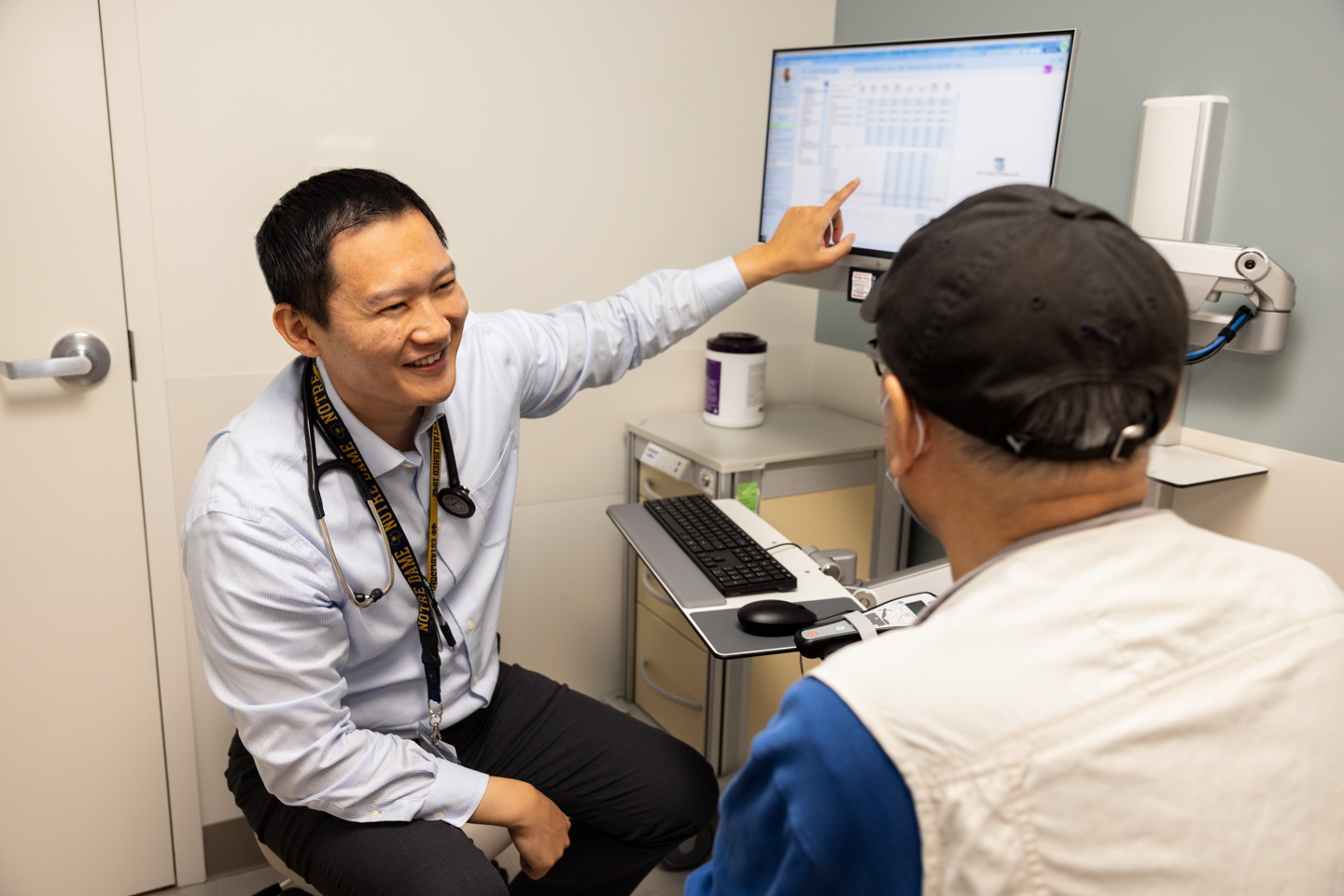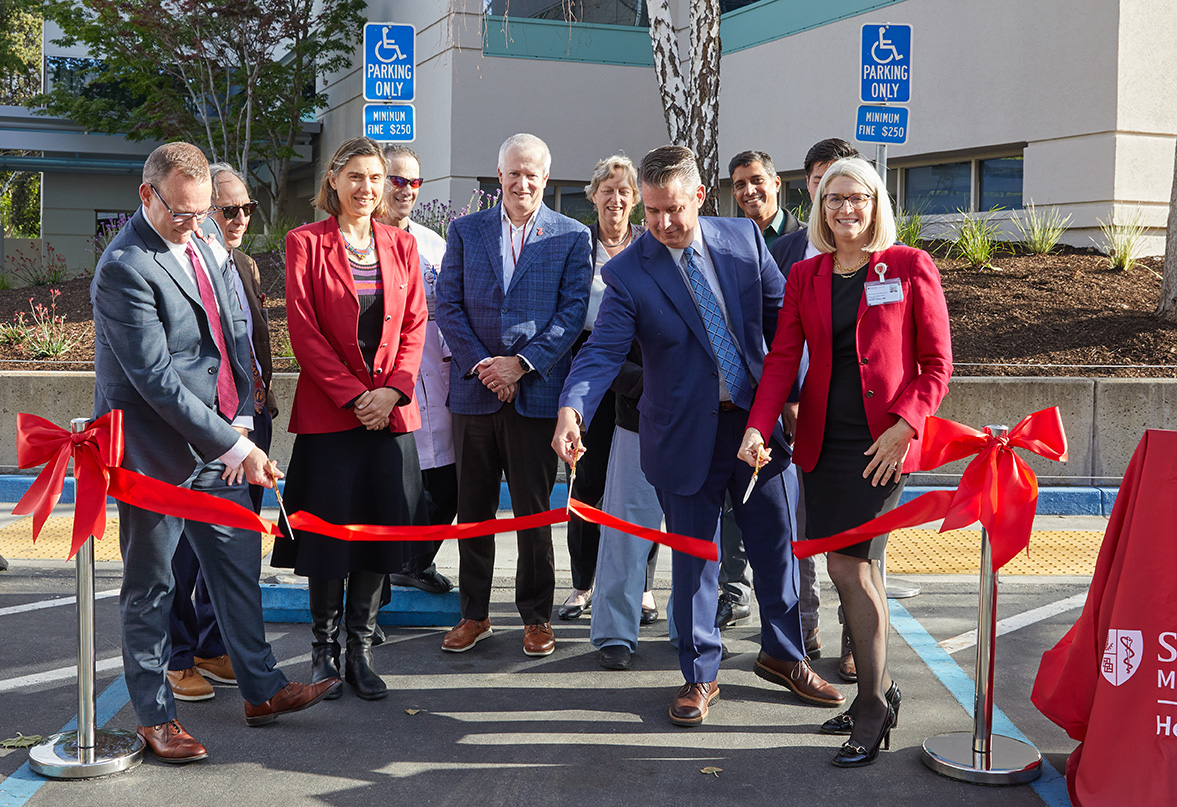
Bryan Wu, MD, takes care of a patient at the Cardiovascular Medicine clinic in San Jose, California.
Stanford Is Going South
New Cardiovascular Clinic Brings Stanford Care to South Bay Communities

Bryan Wu, MD, takes care of a patient at the Cardiovascular Medicine clinic in San Jose, California.
Stanford Is Going South
New Cardiovascular Clinic Brings Stanford Care to South Bay Communities
The Department of Medicine’s growth mindset has taken shape in the form of a brand-new Cardiovascular Medicine (CVM) clinic, which opened its doors in spring 2023 at Stanford Health Care in San José, California. The driving force behind the clinic is an interest in expanding not only Stanford’s geographic footprint but also the diversity of its patients.
Expanding to Diversify the Patient Population
According to its champion, Eldrin Lewis, MD, “In California, patients don’t like to travel much for health care, especially routine health care. So, meeting the patient where they live is a rallying cry that I have been seeing during the time that I have been [working at Stanford].” Combined with similar endeavors, the new CVM clinic provides the opportunity for Stanford to expand beyond its traditional role as a “boutique” health care facility that people must travel to in order to receive high-quality tertiary and quaternary care to a system that cares for patients across the spectrum of disease severity and type, right in their own California communities.
Expansion of cardiology services first focused on the East Bay, but when the opportunity arose for a CVM clinic to provide ambulatory care in the South Bay, Lewis and his team jumped on it. Since opening, the clinic facility has had space to see 16 patients at once.
“This is an opportunity to increase the diversity of the patients that we see in terms of race and ethnicity, with a larger Hispanic and Vietnamese population in the South Bay,” he says. “It allows us to see patients who may not have made the drive up to Palo Alto.” Lewis is Simon H. Stertzer, MD, Professor of Cardiovascular Medicine and chief of the division of cardiovascular medicine in the Department of Medicine.
Growing to Bring Specialty Care to the Doorsteps of New Communities
While several general cardiologists and a few electrophysiologists and interventional cardiologists were already working in the South Bay, the breadth of expertise that Stanford can offer was lacking.
In addition to standard cardiovascular care, the new CVM clinic provides access to specialists in preventive cardiology as well as experts in heart failure, transplant, and adult congenital heart disease. It currently offers echocardiography and stress echocardiography, and Lewis hopes to eventually add nuclear medicine, cardiac magnetic resonance imaging, and CT angiography. It makes a welcome companion to the Santa Clara location of the Stanford South Asian Translational Heart Initiative (SSATHI) clinic, which is home to cardiologists who specialize in the needs of the South Asian population.
“A lot of patients can [now] stay in San José,” says Lewis. “Those who need more complex procedures or surgeries can come into Palo Alto to Stanford Health Care, then continue to be managed [closer to home]. … I would love to be a resource to the greater South Bay community. … I would also like to see the opportunity for educating the community with health fairs and a variety of other things for people who are not necessarily being seen by one of our providers.”
Renewal Through New Relationships
Lewis has made several forays into the South Bay to talk up the clinic to local cardiologists, regional hospitals, and the community at large, describing what the new clinic has to offer while also emphasizing that the goal is to work in partnership with local physicians to provide excellent patient care. “We want to provide the right care at the right time to the right patient,” he says. “My philosophy is that it should be a bidirectional process.” Patients can remain with their current cardiologists, only venturing to the South Bay clinic when they require specialized care.
An official ribbon cutting ceremony marked the opening of the Department of Medicine’s cardiovascular medicine clinic at Stanford Health Care in San José, California
The Department of Medicine’s growth mindset has taken shape in the form of a brand-new Cardiovascular Medicine (CVM) clinic, which opened its doors in spring 2023 at Stanford Health Care in San José, California. The driving force behind the clinic is an interest in expanding not only Stanford’s geographic footprint but also the diversity of its patients.
Expanding to Diversify the Patient Population
According to its champion, Eldrin Lewis, MD, “In California, patients don’t like to travel much for health care, especially routine health care. So, meeting the patient where they live is a rallying cry that I have been seeing during the time that I have been [working at Stanford].” Combined with similar endeavors, the new CVM clinic provides the opportunity for Stanford to expand beyond its traditional role as a “boutique” health care facility that people must travel to in order to receive high-quality tertiary and quaternary care to a system that cares for patients across the spectrum of disease severity and type, right in their own California communities.
Expansion of cardiology services first focused on the East Bay, but when the opportunity arose for a CVM clinic to provide ambulatory care in the South Bay, Lewis and his team jumped on it. Since opening, the clinic facility has had space to see 16 patients at once.
“This is an opportunity to increase the diversity of the patients that we see in terms of race and ethnicity, with a larger Hispanic and Vietnamese population in the South Bay,” he says. “It allows us to see patients who may not have made the drive up to Palo Alto.” Lewis is Simon H. Stertzer, MD, Professor of Cardiovascular Medicine and chief of the division of cardiovascular medicine in the Department of Medicine.
Growing to Bring Specialty Care to the Doorsteps of New Communities
While several general cardiologists and a few electrophysiologists and interventional cardiologists were already working in the South Bay, the breadth of expertise that Stanford can offer was lacking. In addition to standard cardiovascular care, the new CVM clinic provides access to specialists in preventive cardiology as well as experts in heart failure, transplant, and adult congenital heart disease. It currently offers echocardiography and stress echocardiography, and Lewis hopes to eventually add nuclear medicine, cardiac magnetic resonance imaging, and CT angiography. It makes a welcome companion to the Santa Clara location of the Stanford South Asian Translational Heart Initiative (SSATHI) clinic, which is home to cardiologists who specialize in the needs of the South Asian population.
“A lot of patients can [now] stay in San José,” says Lewis. “Those who need more complex procedures or surgeries can come into Palo Alto to Stanford Health Care, then continue to be managed [closer to home]. … I would love to be a resource to the greater South Bay community. … I would also like to see the opportunity for educating the community with health fairs and a variety of other things for people who are not necessarily being seen by one of our providers.”

Renewal Through New Relationships
Lewis has made several forays into the South Bay to talk up the clinic to local cardiologists, regional hospitals, and the community at large, describing what the new clinic has to offer while also emphasizing that the goal is to work in partnership with local physicians to provide excellent patient care. “We want to provide the right care at the right time to the right patient,” he says. “My philosophy is that it should be a bidirectional process.” Patients can remain with their current cardiologists, only venturing to the South Bay clinic when they require specialized care.
The new clinic will partner with South Bay primary care physicians who are part of the Stanford Medical Foundation, acting as a local resource for the cardiology care their patients need. “On average, if you have a single general cardiologist paired to five to 10 primary care doctors, you can create ecosystems where you really get to know those primary care doctors,” says Lewis. “That is something I would like to see develop a little bit more.”

This is just one part of a bigger strategy to expand the network. What I would love to see in five years is Stanford reaching out beyond the East and South Bay, where we are now, to go farther east into the Central Valley.
Looking Forward
“This is just one part of a bigger strategy to expand the network,” he continues. “What I would love to see in five years is Stanford reaching out beyond the East and South Bay, where we are now, to go farther east into the Central Valley.” This is an area of California with limited access to specialized care, and patients experiencing acute cardiac events or with conditions that require special expertise to manage may opt not to drive several hours to obtain the care they need. “The majority of Americans live outside of urban areas, and those are the forgotten people, sometimes.”
